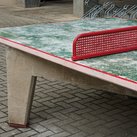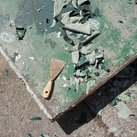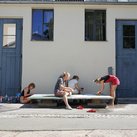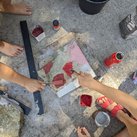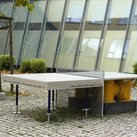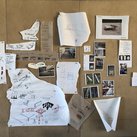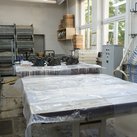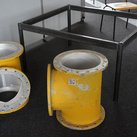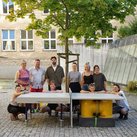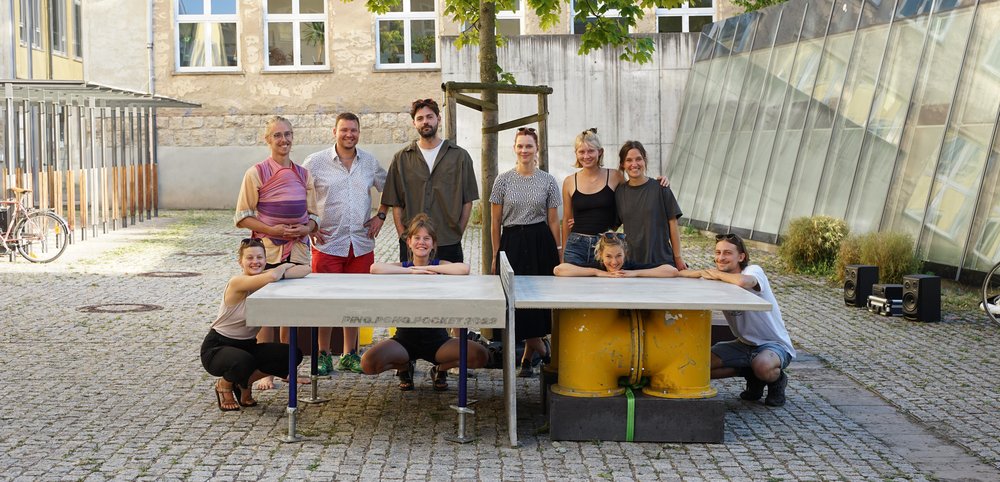

Ping.Pong.Pocket
In dem zweiwöchigen Bauworkshop im Rahmen des interdisziplinären Bauhaus Moduls und mit Unterstützung des Kreativfonds bauten zehn Studierende innerhalb von 12 Tagen zwei neue Tischtennisplatten und schafften so neue, dringend notwendige Aufenthalts- und Sportflächen für die Bauhaus-Universität und deren Nachbarschaft.
Die Gruppe beschäftigte sich schon während des Semesters mit der Sportart, ihrer Wirkung im öffentlichen Raum und dem zirkulären Bauen. In kurzen Input-Vorträgen von Expert*innen aus der Praxis stimmten sich die Teilnehmenden auf die Themen ein. Maßgebend für den Entwurfs- und Bauprozess war die Frage, wie eine Ästhetik des Wiederverwendens und der Wiederverwertens aussehen kann.
Die Tischtennisplatte im Hof der Marienstraße wurde gebraucht gekauft, die Oberfläche behutsam repariert, Fehlstellen in Farbe ausgebessert und als solche sichtbar belassen. Die unterschiedlichen Zeitschichten bleiben erhalten und können direkt abgelesen werden. Mit ihrer wiedergewonnenen glatten Oberfläche wird sie ihrer Funktion als Spielgerät gerecht. Die zweite Platte im Hof der Coudraystraße wurde aus wiederverwendeten Bauteilen und Recyclingbeton gefertigt. So besteht das Netz aus einem gebrauchten Gitterrost, die Füße aus alten Stahlrohren. Die zweiseitige Platte spielt mit dem Nebeneinander und der Gegensätzlichkeit von leichten und schweren, von dünnen und massigen Elementen. Die aus mehreren Einzelteilen bestehende Platte kann jederzeit an einem anderen Ort wiederaufgebaut und durch einseitig verstellbare Füße an unterschiedliche Bodengegebenheiten angepasst werden.
Die Entwürfe sind im Prozess des Ausprobierens in den Werkstätten und in der Diskussion innerhalb der Gruppe entstanden und richteten sich nach den verfügbaren Materialien und den vorhanden Gegebenheiten. Die Professur Werkstoffe des Bauens und das Betonlabor mit seinen Mitarbeiter*innen standen den Studierenden beim Thema Betonsanierung und Recyclingbeton zur Seite. Die Studierenden nutzen das volle Potential der Universität aus: sie arbeiteten im Betonlabor, in der Metallwerkstatt, in der Modellbau- und Holzwerkstatt, bewegten sich auf dem Hauptcampus, in der Marienstraße und lernten den Campus Coudraystraße neu kennen.
Die beiden Platten sollen zunächst bis November 2022 im Einsatz sein. Im Anschluss daran soll die Nutzung evaluiert und über den weiteren Verbleib entschieden werden.
Plattensanierung - Marienstraße
Wiederverwendet und Wiederverwertet - Coudraystraße
In the two-week construction workshop as part of the interdisciplinary Bauhaus module and supported by Kreativfonds, 10 students built two new table tennis tables within 12 days, creating urgently needed recreational and sports areas for the Bauhaus University and its neighborhood.
During the semester, the group already dealt with table tennis, its effect in public space, circular construction, recycled concrete. In short input lectures by experts, the participants got in the mood for the topics. The principles of recycling and upcycling were decisive for the design and construction process. The table tennis table in the courtyard of Marienstraße was bought second-hand, the surface was upgraded, sealed and repaired so that the table is now playable again in new colors and with a smooth surface.The ping pong table that now enhances the courtyard at the Coudraystraße campus was made from recycled concrete and reused components. For example, the net is a used grating, and the feet are old steel pipes. The designs were created in the process of trial and error in the workshops and in group discussion, and were guided by the available materials and existing conditions. The Professorship of "Werkstoffe des Bauens" and the Concrete Laboratory with its staff assisted the students with the topic of concrete rehabilitation and recycled concrete. The full potential of the university could be used: the students worked in the concrete laboratory, in the metal workshop, in the model construction and wood workshop, moved around the main campus, in Marienstraße and got to know the Coudraystraße campus in a new way.
The two tables will initially be in use until November 2022. After that, their use will be evaluated and a decision will be made on their continued use.

